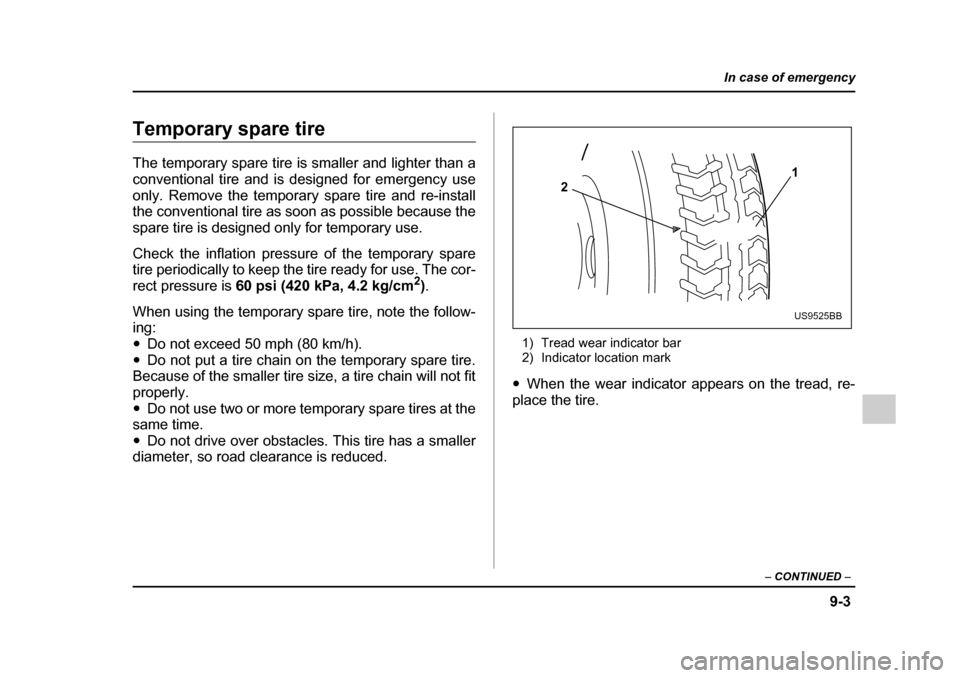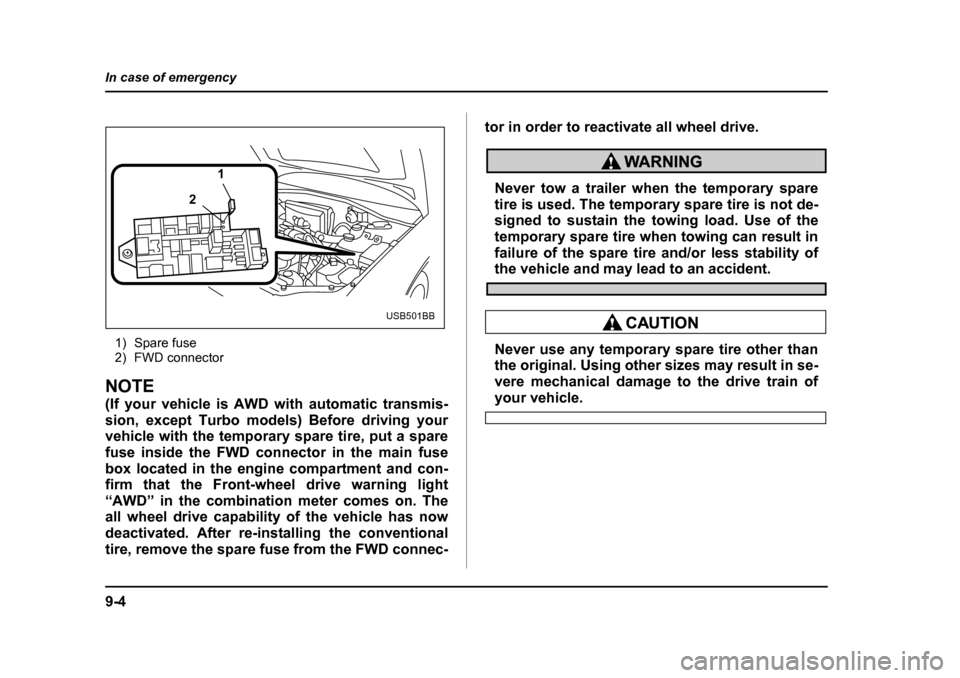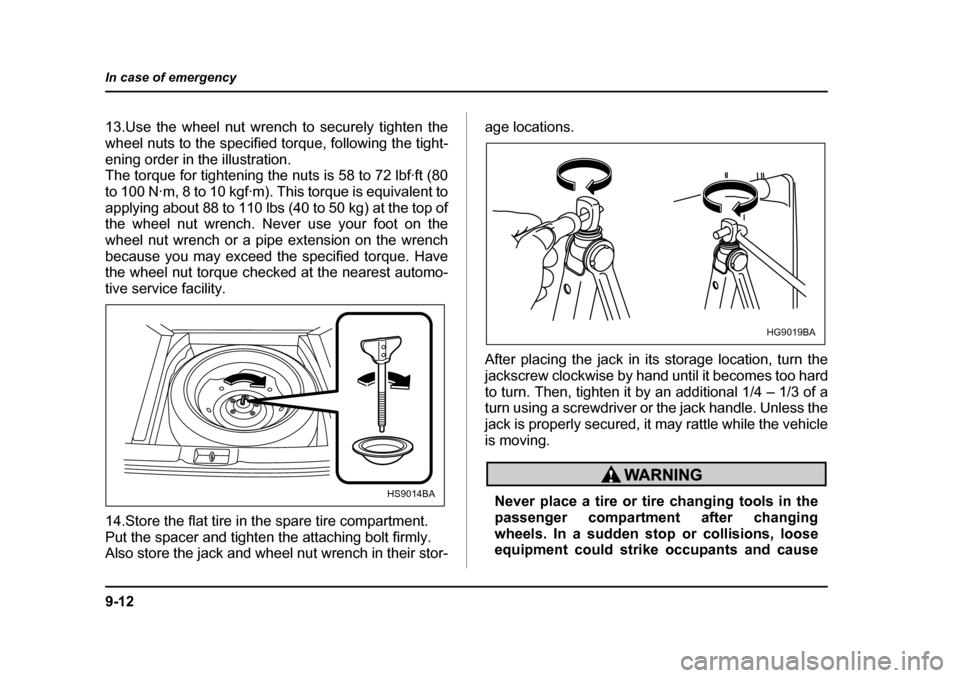Page 348 of 507

9-1
9
In case of emergency
If you park your vehicle in case of an emergency ................................................. 9-2
Temporary spare tire .................................... 9-3
Flat tires ......................................................... 9-5 Changing a flat tire ........................................... 9-5
Jump starting ................................................ 9-13 How to jump start ............................................. 9-14
Engine overheating ....................................... 9-16 If steam is coming from the engine compartment .................................................. 9-16
If no steam is coming from the engine
compartment .................................................. 9-16
Towing ........................................................... 9-17 Towing and tie-down hooks ............................ 9-18
Using a flat-bed truck ....................................... 9-20
Towing with all wheels on the ground ............ 9-21
Rear gate – if the rear gate cannot be unlocked ..................................................... 9-22
Moonroof – if the moonroof cannot be closed ......................................................... 9-23
Maintenance tools ......................................... 9-24 Jack and jack handle ........................................ 9-24
Page 350 of 507

9-3
In case of emergency
– CONTINUED –
Temporary spare tire
The temporary spare tire is smaller and lighter than a
conventional tire and is designed for emergency use
only. Remove the temporary spare tire and re-install
the conventional tire as soon as possible because the
spare tire is designed only for temporary use.
Check the inflation pressure of the temporary spare
tire periodically to keep the tire ready for use. The cor-
rect pressure is 60 psi (420 kPa, 4.2 kg/cm 2
).
When using the temporary spare tire, note the follow-
ing: �y Do not exceed 50 mph (80 km/h).
�y Do not put a tire chain on the temporary spare tire.
Because of the smaller tire size, a tire chain will not fit
properly. �y Do not use two or more temporary spare tires at the
same time. �y Do not drive over obstacles. This tire has a smaller
diameter, so road clearance is reduced. 1) Tread wear indicator bar
2) Indicator location mark
�y When the wear indicator appears on the tread, re-
place the tire.
1
2
US9525BB
Page 351 of 507

9-4
In case of emergency
1) Spare fuse
2) FWD connector
NOTE
(If your vehicle is AWD with automatic transmis-
sion, except Turbo models) Before driving your
vehicle with the temporary spare tire, put a spare fuse inside the FWD connector in the main fuse
box located in the engine compartment and con-
firm that the Front-wheel drive warning light
“AWD” in the combination meter comes on. The
all wheel drive capability of the vehicle has now
deactivated. After re-installing the conventional
tire, remove the spare fuse from the FWD connec-
tor in order to reactivate all wheel drive.
Never tow a trailer when the temporary spare
tire is used. The temporary spare tire is not de-
signed to sustain the towing load. Use of the
temporary spare tire when towing can result in
failure of the spare tire and/or less stability of
the vehicle and may lead to an accident.
Never use any temporary spare tire other than
the original. Using other sizes may result in se-
vere mechanical damage to the drive train of
your vehicle.
1
2
USB501BB
Page 353 of 507
9-6
In case of emergency
Sedan
1) Jack
2) Jack handle
3) Spare tire
Wagon
1) Jack
2) Jack handle
3) Spare tire
5. Take out the spare tire, jack, and wheel nut wrench.
The spare tire is stored under the floor of the trunk or
cargo area.
To remove the spare tire, proceed as follows:
1
2 3
UG9045BB
3
1
2
UG9502BB
Page 354 of 507
9-7
In case of emergency
– CONTINUED –
Sedan: Remove the floor cover from the trunk. Re-
move the storage compartment (if so equipped).Turn
the attaching bolt counterclockwise, then take the
spare tire out.
Wagon: Open the lid and hang the hook provided on
the under side of the lid on the rear edge of the roof to
keep the lid open.
Remove the storage compartment (if so equipped).
UG9503BA
UG9504BA
Page 355 of 507
9-8
In case of emergency
Turn the attaching bolt counterclockwise, then take
spare tire out.
If the spare tire provided in your vehicle is a temporary
spare tire, carefully read the section “Temporary spare
tire” in this chapter and strictly follow the instructions.
The jack is stored on the left side of the trunk or cargo
area.
To take out the jack:
Remove the cover, turn the jackscrew counterclock-
wise to loosen it, then remove the jack.
If the jackscrew is too tight to be loosened by hand,
loosen it using a screwdriver or the jack handle.
The jack handle is stored under the spare tire cover.
NOTE
Make sure the jack is well lubricated before using it.
UG9505BA
HG9017BA
Page 358 of 507
9-11
In case of emergency
– CONTINUED –
10.Before putting the spare tire on, clean the mounting surface of the wheel and hub with a cloth.
11.Put on the spare tire. Replace the wheel nuts.
Tighten them by hand.
Do not use oil or grease on the wheel studs or
nuts when the spare tire is installed. This could
cause the nuts to become loose and lead to an
accident.
12.Turn the jack handle counterclockwise to lower the
vehicle.
HS9011BA
UB9220BA
1
42
53
UG9511BB
Page 359 of 507

9-12
In case of emergency
13.Use the wheel nut wrench to securely tighten the
wheel nuts to the specified torque, following the tight-
ening order in the illustration.
The torque for tightening the nuts is 58 to 72 lbf·ft (80
to 100 N·m, 8 to 10 kgf·m). This torque is equivalent to
applying about 88 to 110 lbs (40 to 50 kg) at the top of
the wheel nut wrench. Never use your foot on the
wheel nut wrench or a pipe extension on the wrench
because you may exceed the specified torque. Have
the wheel nut torque checked at the nearest automo-
tive service facility.
14.Store the flat tire in the spare tire compartment.
Put the spacer and tighten the attaching bolt firmly.
Also store the jack and wheel nut wrench in their stor-
age locations.
After placing the jack in its storage location, turn the
jackscrew clockwise by hand until it becomes too hard
to turn. Then, tighten it by an additional 1/4 – 1/3 of a
turn using a screwdriver or the jack handle. Unless the
jack is properly secured, it may rattle while the vehicleis moving.
Never place a tire or tire changing tools in the
passenger compartment after changing
wheels. In a sudden stop or collisions, loose
equipment could strike occupants and causeHS9014BA
HG9019BA